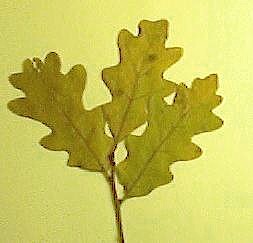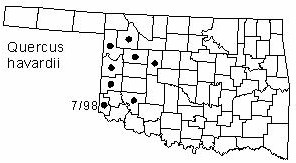
Low shrub to 1.5 m (5 ft), or occasionally a small tree. Forms large clones by extending rhizomes through the sandy soil where it is usually found. Twigs slender, brown, usually hairy. Bark on larger stems light gray, scaly. Leaves alternate, oblong, ovate, or elliptical, margins wavy or shallowly lobed, rounded at base, 2-8 cm (0.8-3.1 in) long, 2-4 cm (0.8-1.6 in) wide, glabrous shiny green above, whitish and densely hairy below. Fruits are acorns maturing in the first year, 15-25 mm (0.6-1 in) long and wide, with scaly cup covering about 1/3 to 1/2.
Distribution: Native to western Oklahoma, west Texas, eastern New Mexico. (A variety occurs in northern Arizona and southern Utah.)
Habitat in Oklahoma: deep sandy soils.
Comment: Q. havardii is the major component of the "shinnery" of western Oklahoma, although several other shrubby oak species are found in the area. Clones of taller plants found scattered through the eastern part of the shinnery vegetation type are thought to be a result of hybridization with Q. stellata. The word "shinnery" seems to be derived from chęne (French for oak), and not from the size of the plant. Quercus is the ancient classical name for the European oaks; havardii honors the American botanist Valery Havard.
NWI status: none
Distribution in Oklahoma: 
BACK
NEXT
RETURN TO INDEX
Last update: 9/16/99
 Go to Oklahoma Biological Survey Home Page
Go to Oklahoma Biological Survey Home Page
 Disclaimer
Disclaimer